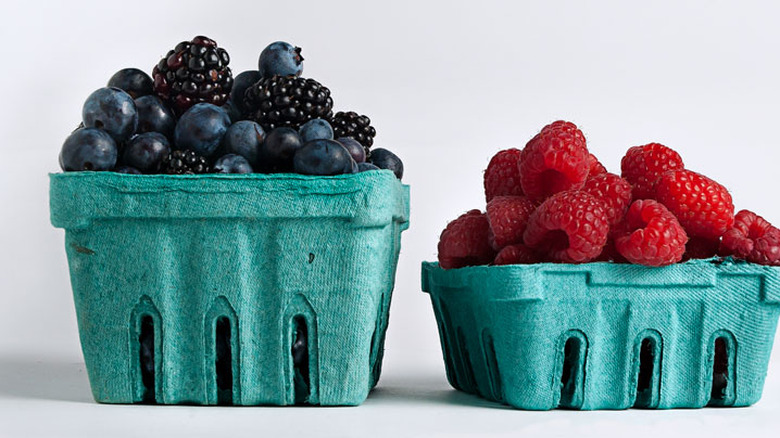How To Store Blueberries, Raspberries And Strawberries
Seasonal, jewel-toned berries' small stature belies a mighty flavor, and their delicate flesh is as ephemeral as summer itself. This means you've got to treat 'em right if you want the best they have to offer. We talked to Steven Satterfield, chef at Miller Union in Atlanta and author of seasonal produce cookbook, Root to Leaf, about the best way to clean, store and handle berries. Take heed and ye shall be rewarded.
Not all berries are created equal. All berries are delicate, but some are more delicate than others. Blueberries are the sturdiest of the bunch, according to Satterfield, "They don't absorb moisture, and their skin is the most protective." They also keep best and are the slowest to deteriorate. Super-absorbent strawberries, on the other hand, are a bit trickier. "They sop up water like a sponge," he says.
Caneberries, such as blackberries and raspberries, deteriorate precipitously. You've probably had it happen: You forgot that gorgeous pint of farmers' market blackberries on the counter for a couple hours, only to find them fuzzy upon your return.
What's up with that? As food scientist Harold McGee explains in On Food and Cooking, all ripening is triggered by a fruit's own ethylene production. But some fruits, called "climacteric," don't just produce their own ethylene; they're also stimulated by it to make even more. This is why fruits like avocados and bananas continue to ripen after they're picked. These climacteric fruits "respire," changing oxygen into carbon dioxide—and eventually switching from ripening to deteriorating.
This decline doesn't happen as quickly for big, tough-skinned fruits like avocados. But, it's exceptionally fast for small, delicate-skinned climacteric berries, like blueberries and caneberries (blackberries and raspberries). In fact, says McGee, caneberries have one of the highest respiration rates of any fruit, period.
RELATED Our Favorite Berry Recipes "
Even though blueberries and caneberries are climacteric, they don't benefit from additional ripening after they've been picked. They may soften, but won't taste any better. And strawberries are non-climacteric, which means they don't enjoy any improvement after harvest. If they're picked under-ripe and rubbery, under-ripe and rubbery they will stay. It behooves you, then, to buy the ripest berries possible. Farmers' market berries should be freshest, ostensibly traveling the shortest distance after picking. For grocery berries, Satterfield advises inspecting the bottom of the containers. Are they greenish? Does the absorbent pad have lots of liquid? See any with mold? If yes to any of the above, skip 'em.
Climacteric or non-, all berries decline rapidly, but you can keep it at bay by using the fridge, Satterfield advises. Store most berries dry and in the container in which you bought them, he says, except for strawberries, which tend to dry out in the fridge. Satterfield recommends storing them atop a dry towel after washing (in a single layer, if possible), with a damp towel placed over the top, and eating them within in a day or two.
Avoid keeping your berries in the coldest part of your fridge, lest they suffer frost damage. But, notes Satterfield, the ideal place in your fridge is where you'll see them best. You don't have to worry about sad, sorry berries if you eat them quickly enough.
Wash when opportune
Remember Satterfield's advice about storing berries "dry and in the container in which you bought them"? That means washing only the amount of berries you plan to eat, right before you eat them. Otherwise, store them dirty, and be sure the container is breathable. Soggy or damp berries go downhill fast.
When you're ready, wash each berry differently. Blueberries can take about any method, apart from a long soaking. Strawberries, with their delicate, absorbent skin, require a little more care: Quickly swish unwashed berries in a bowl of water, move them to a strainer, then move them to paper towels, placed in single layers and let them dry. Satterfield says, "A lot of times, strawberries look clean, but once you wash them, you'll see they aren't; pollen, dirt—you'll be surprised by what you'll find in the bowl." If you can get away with not washing caneberries, don't. Once water gets in all the nooks and crannies of these composite fruits, texture is compromised. If you must, he says, spritz them quickly, then dry gently.
The freezer is your friend. Say you can't possibly eat all those berries before they spoil. This is where the freezer steps in. Wash berries and dry thoroughly, then lay them out in a single layer (so they don't freeze in giant clumps) on a wax paper-lined pan or baking sheet. Once frozen, transfer the berries to an airtight, zip-top bag. If they freeze separately on the sheet, they'll stay that way in the bag, too, which is optimal for smoothie-making or popping straight into your mouth on a hot, summer day.

